Reference
- Swanton, John Reed (1922). Early History of the Creek Indians and Their Neighbors, Volume 73. Washington, DC: Smithsonian Institution.
Fushatchee was a band of Muscogee Native Americans. They were located in Alabama and Florida in the United States. [1]
The Fushatchee may have come out of three different Muscogee tribes: Kanhatki, Kolomi, and the Atasi. Europeans first recorded them in 1733. Traders tracked them as being in the same location until 1797. Some traders called them the "Coosahatchies of Swan." Indian agent Benjamin Hawkins wrote that the Fushatchee's village was on flat land on the south side of the Tallapoosa River. The tribe cultivated corn on each side of the river, and dug a moat for fortification. Additional, older settlements were found down the river.
After the Red Stick War, the Fushatchee relocated to northern Florida. They disappeared in census data after 1832. French censuses suggest the tribe merged with the Kanhatki. [2]
After the Seminole Wars, the US federal government forcefully relocated them and the Seminole people further west, and eventually into Indian Territory. The tribe would be represented by the Seminole.
The Fushatchee tribal town in the Alabama and Florida and their ceremonial ground in Oklahoma is called Liwahali. [3]
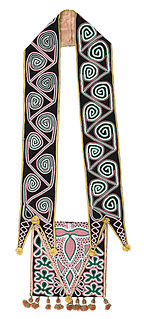
The Muscogee, also known as the Mvskoke, Muscogee Creek, and the Muscogee Creek Confederacy, are a group of related indigenous peoples of the Southeastern Woodlands in the United States of America. Their original homelands are in what now comprises southern Tennessee, much of Alabama, western Georgia and parts of northern Florida.
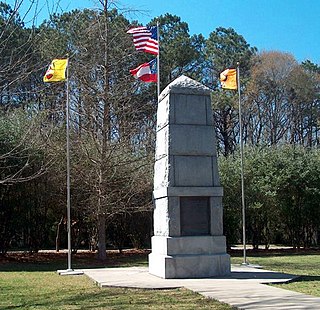
The Trail of Tears was a series of forced displacements of approximately 60,000 American Indians of the "Five Civilized Tribes" between 1830 and 1850 by the United States government. Part of the Indian removal, the ethnic cleansing was gradual, occurring over a period of nearly two decades. Members of the so-called "Five Civilized Tribes"—the Cherokee, Muscogee (Creek), Seminole, Chickasaw, and Choctaw nations —were forcibly removed from their ancestral homelands in the Southeastern United States to areas to the west of the Mississippi River that had been designated Indian Territory. The forced relocations were carried out by government authorities after the passage of the Indian Removal Act in 1830. The Cherokee removal in 1838 was brought on by the discovery of gold near Dahlonega, Georgia, in 1828, resulting in the Georgia Gold Rush.
Creek mythology is related to a Muscogee tribe who are originally from the southeastern United States, also known by their original name Mvskoke, the name they use to identify themselves today. Mvskoke is their name in traditional spelling. Modern Muscogees live primarily in Oklahoma, Alabama, Georgia, and Florida. Their language, Mvskoke, is a member of the Eastern branch of the Muskogean language family. The Seminole are close kin to the Mvskoke and speak an Eastern Muskogean language as well. The Muscogee were considered one of the Five Civilized Tribes. After the Creek War many of the Muscogee escaped to Florida to create the Seminole.

The term Five Civilized Tribes was applied by European Americans in the colonial and early federal period in the history of the United States to the five major Native American nations in the Southeast—the Cherokee, Chickasaw, Choctaw, Creek (Muscogee), and Seminole. Americans of European descent classified them as "civilized" because they had adopted attributes of the Anglo-American culture. Examples of such colonial attributes adopted by these five tribes, included Christianity, centralized governments, literacy in English, market participation, written constitutions, intermarriage with white Americans, and chattel slavery practices, including purchase of enslaved African Americans. For a period, the Five Civilized Tribes tended to maintain stable political relations with the European Americans, before the United States promoted Indian Removal of these tribes from the Southeast.
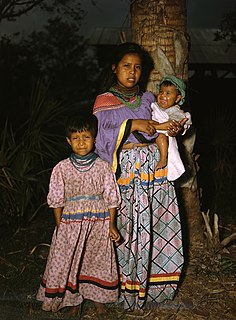
The Seminole are a Native American people who developed in Florida in the 18th century. Today, they live in Oklahoma and Florida, and comprise three federally recognized tribes: the Seminole Nation of Oklahoma, the Seminole Tribe of Florida, and Miccosukee Tribe of Indians of Florida, as well as independent groups. The Seminole people emerged in a process of ethnogenesis from various Native American groups who settled in Spanish Florida beginning in the early 1700s, most significantly northern Muscogee Creeks from what is now Georgia and Alabama.

Osceola, named Billy Powell at birth in Alabama, became an influential leader of the Seminole people in Florida. His mother was Muscogee, and his great-grandfather was a Scotsman, James McQueen. He was reared by his mother in the Creek (Muscogee) tradition. When he was a child, they migrated to Florida with other Red Stick refugees, led by a relative, Peter McQueen, after their group's defeat in 1814 in the Creek Wars. There they became part of what was known as the Seminole people.

John Reed Swanton was an American anthropologist, folklorist, and linguist who worked with Native American peoples throughout the United States. Swanton achieved recognition in the fields of ethnology and ethnohistory. He is particularly noted for his work with indigenous peoples of the Southeast and Pacific Northwest.

Ocmulgee Mounds National Historical Park in Macon, Georgia, United States preserves traces of over ten millennia of culture from the Native Americans in the Southeastern Woodlands. Its chief remains are major earthworks built before 1000 CE by the South Appalachian Mississippian culture These include the Great Temple and other ceremonial mounds, a burial mound, and defensive trenches. They represented highly skilled engineering techniques and soil knowledge, and the organization of many laborers. The site has evidence of "17,000 years of continuous human habitation." The 3,336-acre (13.50 km2) park is located on the east bank of the Ocmulgee River. Macon, Georgia developed around the site after the United States built Fort Benjamin Hawkins nearby in 1806 to support trading with Native Americans.

Alexander McGillivray, also known as Hoboi-Hili-Miko, was a Muscogee (Creek) leader. The son of a Muscogee mother and a Scottish father, he had skills no other Creek of his day had: he was not only literate but educated, and he knew the "white" world and merchandise trading well. These gave him prestige, especially with European-Americans, who were glad to finally find a Creek leader they could talk to and deal with. He used his role as link between the two worlds to his advantage, not always fairly, and became the richest Creek of his time.

The Yuchi people, also spelled Euchee and Uchee, are a Native American tribe based in Oklahoma.
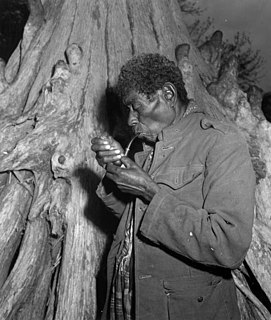
The Black Seminoles, or Afro-Seminoles are Indian-Negroes associated with the Seminole people in Florida and Oklahoma. They are mostly blood descendants of the Seminole people, free blacks, and escaped slaves, who allied with Seminole groups in Spanish Florida. Many have Seminole lineage, but due to the stigma of having very dark or black skin and kinky hair, they all have been categorized as slaves or freedmen.
The Hitchiti were a historic indigenous tribe in the Southeast United States. They formerly resided chiefly in a town of the same name on the east bank of the Chattahoochee River, four miles below Chiaha, in western present-day Georgia. The natives possessed a narrow strip of good land bordering on the river. The Hitchiti had a reputation of being honest and industrious.
The Apalachicola were a group of Native Americans related to the Muscogee people. They spoke a Muskogean language related to Hitchiti. They lived along the Apalachicola River in present-day Florida. Their name derives probably from Hitchiti Apalachicoli or Muskogee Apalachicolo, signifying apparently "People of the other side", with reference probably to the Apalachicola River or some nearby stream.

The Cusabo or Cosabo were a group of American Indian tribes who lived along the coast of the Atlantic Ocean in what is now South Carolina, approximately between present-day Charleston and south to the Savannah River, at the time of European colonization. English colonists often referred to them as one of the Settlement Indians of South Carolina, tribes who "settled" among the colonists.
Ahaya was the first recorded chief of the Alachua band of the Seminole tribe. European-Americans called him Cowkeeper, as he held a very large herd of cattle.
The indigenous peoples of Florida lived in what is now known as Florida for more than 12,000 years before the time of first contact with Europeans. However, the indigenous Floridians living east of the Apalachicola River had largely died out by the early 18th century. Some Apalachees migrated to Louisiana, where their descendants now live; some were taken to Cuba and Mexico by the Spanish in the 18th century, and a few may have been absorbed into the Seminole and Miccosukee tribes.
Uchee Billy or Yuchi Billy was a chief of a Yuchi band in Florida during the first half of the 19th century. Uchee Billy's band was living near Lake Miccosukee when Andrew Jackson invaded Spanish Florida during the First Seminole War and attacked the villages in the area. Yuchi Billy and his band then moved to the St. Johns River. During the Second Seminole War, Uchee Billy was an ally of the Seminoles, and was one of the principal war chiefs who fought the U.S. Army.
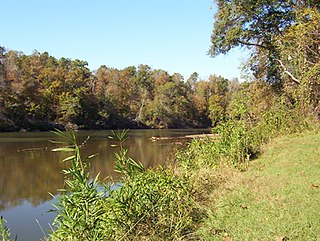
The Tallapoosas were a division of the Upper Creeks in the Muscogee Confederacy. Prior to Removal to Indian Territory, Tallapoosa lived along the Tallapoosa River in Alabama.
Hickory Ground, also known as Otciapofa is an historic Upper Muscogee Creek tribal town and an archaeological site in Elmore County, Alabama near Wetumpka. It is known as Oce Vpofa in the Muscogee language; the name derives from oche-ub,"hickory" and po-fau, "among". It is best known for serving as the last capital of the National Council of the Creek Nation, prior to the tribe being moved to the Indian Territory in the 1830s. It was added to the National Register of Historic Places on March 10, 1980.

The Tawasa Indian Tribe, also known as the Alibamu Indian Tribe, was located near the Alabama River, in Autauga County, Alabama. The population of the tribe was known to be around 330 members, all living in or near what were known as the Tawasa and Autauga Towns. The tribe existed around the late 1600s, early 1700s, however somewhat disappeared in the early 1700s, due to violence and flee. The tribe was split, with around 60 members joining the Alabama tribe, at Fort Toulouse. Some time later, the tribe at Fort Toulouse migrated south joining various tribes in Florida. For the remaining count, there is little evidence to show where they all went, however there is evidence to show that some ended up in Oklahoma, along with some Creeks who migrated there.